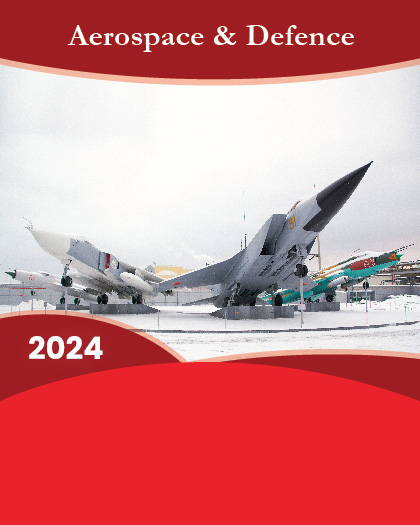
Global Aeroderivative Sensor Market is valued approximately at USD 1.39 Billion in 2023 and is anticipated to grow with a healthy growth rate of more than 9.54% over the forecast period 2024-2032. An aeroderivative sensor is a type of sensor specifically designed to be used with aeroderivative engines. These engines are lightweight and adapted from jet engines, originally designed for aircraft, and are used in various industrial applications, such as power generation and marine propulsion. Aeroderivative sensors play a critical role in monitoring and controlling various parameters of these engines, ensuring optimal performance, efficiency, and safety. These sensors can measure a range of variables, including temperature, pressure, vibration, and airflow. The data collected by aeroderivative sensors is crucial for maintaining the engine's operational integrity, diagnosing potential issues, and optimizing maintenance schedules. The market's growth is fueled by advancements in sensor technology, including the development of new and innovative sensor types and the increasing integration of digital signal processing, data analytics, AI, and ML for sensor data analysis. These trends are expected to continue, driving further growth and innovation in the Aeroderivative Sensor Market.
The Aeroderivative Sensor Market is experiencing significant growth driven by increasing demand for enhanced aircraft efficiency, performance, and reliable sensors for monitoring and controlling aircraft engines. Modern aircraft require advanced sensors to ensure optimal engine performance, fuel efficiency, and safety. Aeroderivative sensors, designed to withstand extreme conditions, provide precise, real-time data crucial for maintaining engine integrity and optimizing operations. As the aviation industry prioritizes reducing operational costs and environmental impact, the need for sophisticated sensors to monitor and control engine parameters intensifies. Additionally, the expansion of the aerospace sector and the adoption of advanced technologies in aircraft further boost the demand for high-quality aeroderivative sensors, positioning the market for significant growth. Furthermore, the market is also benefitting from the rising use of aeroderivative engines in various applications, leading to increased opportunities for sensor manufacturers.
The key region in the Global Aeroderivative Sensor Market includes North America, Europe, Asia Pacific, Latin America, and Middle East & Africa. In 2023, North America dominates the market in terms of revenue, driven by major aerospace and defense industries. The region is home to leading aerospace companies and engine manufacturers, such as General Electric and Honeywell, which drive innovation and development in sensor technology. Significant investments in research and development, coupled with a robust aerospace infrastructure, support the advancement of aeroderivative sensors. Additionally, the presence of major airlines and a strong focus on improving aircraft efficiency and performance further fuel demand. North America's stringent safety regulations and standards ensure the adoption of reliable and high-quality sensors for monitoring and controlling aircraft engines. The Asia-Pacific region is projected to witness fastest CAGR growth, owing to rising demand for air travel and the expansion of the aerospace industry.
Major market player included in this report are:
General Electric Company
Rolls-Royce Holdings plc
Curtiss-Wright Corp.
TransDigm Group, Inc.
Kawasaki Heavy Industries, Ltd.
Honeywell International Inc.
Safran SA
Ishikawajima-Harima Heavy Industries Co., Ltd.
Mitsubishi Heavy Industries, Ltd.
MTU Aero Engines AG
CFM International
Liebherr-Aerospace
Pratt & Whitney Canada Corp.
Woodward, Inc.
The detailed segments and sub-segment of the market are explained below:
By Propulsion Type:
Turbofan
Turboprop
Turboshaft
By Power Rating:
Up to 5,000 SHP
5,000 to 10,000 SHP
10,000 to 15,000 SHP
15,000 SHP and above
By End Use:
Civil Aviation
Military Aviation
Industrial Applications
By Sensor Type:
Temperature Sensors
Pressure Sensors
Vibration Sensors
Speed Sensors
Other Sensors
By Region:
North America
U.S.
Canada
Europe
UK
Germany
France
Spain
Italy
ROE
Asia Pacific
China
India
Japan
Australia
South Korea
RoAPAC
Latin America
Brazil
Mexico
Rest of Latin America
Middle East & Africa
Saudi Arabia
South Africa
RoMEA
Years considered for the study are as follows:
Historical year - 2022
Base year - 2023
Forecast period - 2024 to 2032
Key Takeaways:
Market Estimates & Forecast for 10 years from 2022 to 2032.
Annualized revenues and regional level analysis for each market segment.
Detailed analysis of geographical landscape with Country level analysis of major regions.
Competitive landscape with information on major players in the market.
Analysis of key business strategies and recommendations on future market approach.
Analysis of competitive structure of the market.
Demand side and supply side analysis of the market.
























